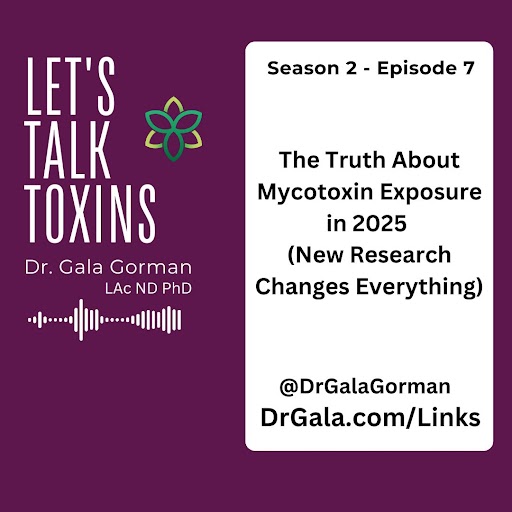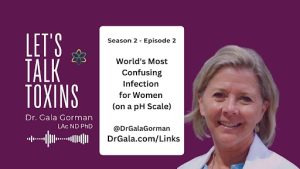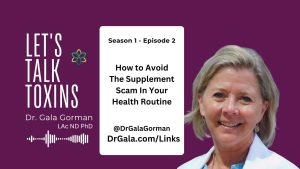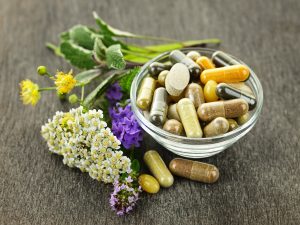NOTE: A machine generated this transcript. Please be aware that it may contain occasional errors in punctuation and spelling.
Mycotoxins can disrupt hormones, weaken the immune system, damage the liver and kidneys, and even increase the risk of miscarriage or cancer. The effects on mature women are even greater—especially those in menopause or postmenopausal—as they may be more susceptible to the health impacts of mycotoxins due to hormonal changes they’ve already experienced and potentially compromised immune systems from accumulated stress that they’re under.
Exposure to mycotoxins can make menopausal symptoms worse and contribute to conditions like endometriosis or polycystic ovary syndrome (PCOS) due to their estrogenic effects.
Welcome to the Let’s Talk Toxin Show. In this episode, I’m focusing on something that affects all of us but often goes unnoticed: mycotoxins and their impact on women’s health during midlife. These sneaky mold toxins are everywhere in our diet and environment and can cause a range of symptoms that can easily be mistaken for other health issues.
If you are experiencing unexplained fatigue, brain fog, or hormonal imbalances, mycotoxins might be the culprit. Stick around because I’m sharing the hidden risks for women. How these toxins affect your nerves and brain, including your dopamine levels, along with practical detoxification methods that will support your body.
Make sure you stay to the end where I provide effective strategies to detox mycotoxins and answer questions about the effects of mold and mycotoxins from women just like you.
And if you’re new here, I’m Dr. Gala Gorman, a licensed acupuncturist, naturopath, and author of “What’s Your Kryptonite?” I wrote the book to help women understand the effects of chronic stress that’s turned toxic.
In the book, I share the MOLT Method™ I developed to make it easy to shed stress along with accumulated toxicity—just like any other creature in nature that’s outgrown its trappings. Many women find their way to me after trying everything to deal with their annoying symptoms. You may feel like you’ve learned more than you ever wanted to know about health and still aren’t healthy.
It’s time for a different approach. Symptoms are directly related to stress, but stress isn’t easy to master and it isn’t going away. If you’re ready for a new approach that will lead to stress mastery, I highly recommend my Wellness Warriors Membership. It’s perfect for those who have a strong sense they’re missing something important—that’s the key to optimal wellness.
In the membership, we apply the MOLT Method™ I developed. MOLT is an acronym: M is for mindset, O is for order, L is for lifestyle, and T is for toxins. It’s designed to help you shed stress, cruise through midlife symptom-free, and end issues like chronic fatigue, insomnia, and even weight gain. Join us and turn your knowledge into real change. You can learn more at DrGala.com/Links.
In this next segment, I share information from research studies related to toxicity. You can think of it as a Toxin Trend. The T in MOLT stands for toxins, as I mentioned a couple of minutes ago, and I can say with confidence that every symptom is caused by accumulated toxicity. I evaluate 12 categories of toxicity when I’m working with someone to unravel a health mystery.
Our world is full of manmade substances that our bodies were not designed to deal with. Couple this toxicity with an overwhelming amount of toxic stressors—the body was designed to manage—and it’s no wonder women find themselves playing whack-a-mole with symptoms.
So, here’s a report that’s a great example of a Toxin Trend. It’s from 2023 published on PubMed, and it made some interesting observations related to the rise in mycotoxin-related illness. The post indicated that rising temperatures and increased humidity due to climate change are creating more favorable conditions for fungi that produce mycotoxins.
These toxins can contaminate crops like wheat, corn, and barley, leading to significant health risks for humans.
Mycotoxins can disrupt hormones, weaken the immune system, damage the liver and kidneys, and even increase the risk of miscarriage or cancer. The effects on mature women are even greater—especially those in menopause or postmenopausal—as they may be more susceptible to the health impacts of mycotoxins due to hormonal changes they’ve already experienced and potentially compromised immune systems from accumulated stress that they’re under.
Exposure to mycotoxins can make menopausal symptoms worse and contribute to conditions like endometriosis or polycystic ovary syndrome (PCOS) due to their estrogenic effects. There are some regional variations; so it isn’t the same everywhere, as we know. Humidity isn’t the same everywhere.
Climate change affects mycotoxin production differently depending on the region and honestly the level of humidity. Warmer temperatures can increase aflatoxin production in crops like maize (essentially corn) and ground nuts. This elevated humidity can lead to higher fumonisin contamination in maize or corn.
In Europe, for example, climate change is altering the distribution of mycotoxins, with aflatoxins becoming more prevalent in previously cooler regions. We’re going to explain more about the different types of mycotoxins as we get into the episode, but just know that aflatoxins are a type of mycotoxin.
Some ways to reduce exposure: It’s essential to adopt good agricultural practices. Most of us aren’t out there tending crops ourselves, but those who do need to make sure they’re using crop rotation and use more resistant varieties. We want to be making sure we’re sourcing foods we eat from high-quality producers.
Predictive models are helping to monitor mycotoxin risks in food and feed—and feed is important because when animals eat these mycotoxin-laced foods, they then have mycotoxins in their tissues and then we’re consuming in the way as well.
The European Environment Agency (EEA) suggests a “One Health” approach to address risks because you’ve got to integrate environment, the animals, and human health considerations.
Chapter 12 in my book “What’s Your Kryptonite?” is dedicated to helping readers manage what I refer to as Tricky Toxins. Our bodies are bombarded with toxicity so we have to learn how to manage it.
Just comment “tricky toxins” and we’ll send you a link where you can download the chapter for free—or if commenting isn’t convenient go to DrGala.com/Links and sign up for my Wellness Weekly newsletter. You can respond to any email you receive from me with “tricky toxins” and we’ll send you a link.
In this next segment, I’m opening the kimono to share how I was challenged to apply my suggestions—I’m Walking My Talk—and here’s an example: every suggestion you’ll hear from me has been tested in the trenches!
That includes saying no to symptom suppression. Over the past four decades, I’ve developed processes that work sustainably. Typically, it requires a combination of approaches that I’ve synthesized to address the health issues that show up repeatedly for many women. So recently, I had an opportunity to Walk My Talk, and I wanna share that experience.
I was in a conference in Phoenix in the last few weeks, and one of the speakers told a story that was really shocking and really made me up level my own approach to dealing with this subject of mycotoxin exposure.
Mold toxicity makes the systems really weak and in this particular case, this speaker, who is very well trained and respected in our field of functional medicine, had this exposure to mold toxicity. It had made her system weak, and she then had a virus that had flared repeatedly. And so, what she said was that she knew a lot, but she really still wasn’t connecting the dots.
And so it wasn’t until she went to a conference a few months previous to this experience and ran into another practitioner like myself, somebody that had mentored her previously and reminded her of something that she was not using. Our microcurrent medicine that we used to help with these kinds of sort of mysterious toxicities.
Some of the things that she learned from this experience that I learned as well are that families don’t necessarily get sick initially, but even if they don’t show signs initially, that doesn’t mean it’s not affecting them. What she’s found now, a few years late,r is that her son is struggling with immune system dysfunction, and really she feels like if she would have mitigated the mold toxicity quicker, she would’ve maybe saved herself and her family some toxic accumulation, the results, these, essentially the effects of toxic accumulation down the road.
This toxin cocktail really is the biggest issue. It’s never just one type of toxicity that pushes somebody over the edge. So in this particular case, what really created a significant issue for her that honestly she’s still trying to fully recover from is this mold toxicity coupled with the viral toxicity and really the stress then associated with being sick and not being able to resolve it herself when she felt like she should have been able to.
And so, so what she said to the audience of hundreds of her peers essentially is that she wouldn’t have believed it if it didn’t happen to her. She would not have believed how bad it could be and how bad the effects of these toxins could be if she hadn’t experienced it for herself.
And so, some of the things you can do is trust your intuition. When you’re feeling like something’s not right and something really seems to be escalating, or you have some kind of infection that just is not receding in a timely manner. You know, make sure you look into some of these other types of toxicity that might be keeping your immune system on overdrive.
Stress really is the trigger. One of my colleagues’ moms was getting ready to go into cancer treatment for recently diagnosed breast cancer. And she was sharing with me that her mom was like the picture of health, and she ate really healthy, and she exercised, and she did all the right things.
But she admitted that her mom led a very stressful life. She had a stressful relationship, and she really had kind of poo-pooed the effect or the trigger essentially that stress was to create this situation of dis-ease escalating to disease in her body. And so just know that stress, undergoing stress, chronic stress is not optional. You have to manage stress in order to keep some of these other toxins from escalating to the point where they’ve become kind of unmanageable or even uncontrollable.
And also that if you hear a story about somebody else who’s experiencing something like this, some mysterious health issue. Please don’t dismiss it. These situations are easy to dismiss until it affects you directly. You may not have the issue directly, but if it affects one of your beloved family members or a really close friend, all of a sudden it’ll hit home and you’ll be like, this person was, you’ll say, I would not have believed it if it had not happened to me.
Now ,let’s continue talking about this hidden health concern that affects many of us, mycotoxins and how they’re silently impacting our health, especially during midlife. Understanding the difference between mold exposure and mycotoxin poisoning is crucial, as these terms are often confused but have distinct implications for our well-being.
Symptoms related to mycotoxin exposure often mimic other conditions, making diagnosis particularly challenging. And while we can’t completely eliminate exposure to these toxins in our food and environment. The good news is that we can take practical steps to reduce our risk.
Let’s explore what recent research tells us about mycotoxin risks for women. The effects of mold toxins in our diet and how supporting our body’s natural detoxification pathways can help maintain optimal health during midlife and beyond.
So ,as promised a moment ago, we’re gonna talk about the different types of mycotoxins. And the first we’ll talk about here is aflatoxins. So aflatoxins are potent carcinogens that can contaminate food products like grains and nuts. They create significant health risks, including liver damage and increased cancer risk.
Aflatoxin exposure can amplify health issues during pregnancy and menopause due to its impact on liver function and immune response. Some detection methods range from traditional culture-based techniques. These typically use a Petri dish to essentially sample the air from the environment or to more advanced molecular and immunochemical approaches like the PCR and ELISA tests.
Strategies to mitigate aflatoxin contamination include physical methods like steam treatment or chemical detoxification, which honestly would have you trading one toxin for another. So this would not be my recommended approach or biological control using nontoxigenic strain. So, that might be a better alternative if steam cleaning is not going to get the job done.
You also wanna make sure that whoever you are sourcing your food from promotes crop resistance. These are all crucial for ensuring food safety and reducing economic losses, and those economic losses are for the growers and for us individually ’cause mitigation is costly.
The next I’ll talk about here is ochratoxin A. It’s usually referred to as OTA or ota. It’s a toxin found in foods like coffee, wine, and dried fruits. It can harm your kidneys, increase cancer risk, and affect your brain, potentially contributing to diseases like Alzheimer’s. OTA can also weaken your immune system, making you more susceptible to infections.
It’s known for its nephrotoxic, hepatotoxic, and carcinogenic properties. So nephrotoxic means toxic to the kidneys, hepatotoxic, toxic to the liver, and obviously carcinogenic properties. We know we wanna avoid that.
These produce significant health risks, including developmental and reproductive toxicity. In animal studies, OTA has been shown to cause congenital defects and reproductive issues. Of course, we haven’t done the tests on the human reproductive health system because we really can’t do this kind of studies on humans. So let’s just trust it when the animals are having a problem that we would most likely have a problem with this kind of toxins as well.
Exposure to OTA during pregnancy can lead to transfer across the placenta, potentially affecting fetal development. It’s been detected in human cord blood and breast milk. And this just highlights the need for minimizing exposure to this type of toxin.
The next toxin I wanna talk about is zearalenone. Some mycotoxin produced by fusarium fungi, and it acts as an estrogenic compound that can disrupt hormonal balance, potentially affecting postmenopausal women by mimicking estrogen in the body. While specific studies on postmenopausal women are limited ZEA, because it’s quite a mouthful.
ZEA’s estrogen-like effects could exacerbate conditions like endometriosis or PCOS, and if you have not picked up on this yet, you’re seeing a repeated theme here that these mycotoxins really do disrupt hormonal balance. So, this can influence menopausal symptoms due to its impact on estrogen receptors.
The general toxicity of ZEA includes reproductive, hepatotoxic, and immunotoxic effects, which could be particularly concerning for older women with preexisting health conditions or compromised immune systems.
So here’s another one. It’s another mouthful. Deoxynivalenol. Let’s just call it DON. This is also known as the vomit toxin, and it is another type of mycotoxin. It’s a member of a family of the fusarium species and particularly a couple of different strains. DON is commonly found in grains like wheat, corn, and barley.
And it can cause acute symptoms like nausea, vomiting, diarrhea, abdominal pain, headache, dizziness, and fever in humans and animals. So you might notice here that this one, you might see the effects of these other mycotoxins we’ve been talking about. DON is known for its heat stability and can persist in food products even after processing.
And as I promised you, there’s some new research related to mycotoxins from February of this year, 2025. A study in Norway and published on Frontiers in Public Health looked at how much mycotoxins waste workers are exposed to compared to people who don’t work in waste management.
The researchers collected urine samples from 33 waste workers and 19 people who didn’t work in waste management to check for signs of mycotoxin exposure. The results showed that waste workers were exposed to several types of mycotoxins, including DON found in 91% of workers, OTA found in 33% of workers, and ZEA found in 17% of workers.
And while the exposure levels for most mycotoxins were not considered a health risk, there were some concerns about OTA; this toxin might pose health risks, especially related to kidney damage and cancer. So they are investigating further.
And remember what I said about the cocktail of toxins and how the combination is often what triggers a serious health issue. So before you just dismiss this and say, I’m not a waste worker know that certainly these people are exposed to a lot more toxicity than the normal person, but that doesn’t mean that in your world you can’t accumulate a number of different types of toxicity that will end up creating an issue for you that is really challenging to unravel.
Now, let’s talk about mold toxins or these mycotoxins and how they grow on food. These toxins can contaminate grains, nuts, fruits, and vegetables and really pose health risks if ingested. Mycotoxins are known to cause a range of symptoms from allergic reactions and respiratory issues to more severe conditions like liver damage and cancer.
Like liver damage and cancer, as we’ve already mentioned, these toxins are naturally occurring and can be found in a variety of food products. And so they pose significant health risks to humans and animals, and they’re really hard to completely avoid.
So, remember the aflatoxins that we mentioned? Those are known for carcinogenic properties and the potential to cause liver damage. OTA or the ochratoxins are linked to kidney damage. Fumonisins cause liver and kidney damage and have been associated with esophageal cancer.
And then there are other food contamination sources that are found just from molds like Aspergillus and Fusarium, and this can happen just during improper storage or handling. So even if it made it through the growing process. If it’s improperly stored or handled, then it can develop these mycotoxins in the process.
Animal products like meats, we mentioned this a moment ago. Mycotoxins can also be present in these products if the animals are consuming contaminated feed. And so this affects consumers like us indirectly.
Besides food, exposure can happen through inhalation of mold spores in damp environments like water damaged buildings, for example. So stick around, and in a few moments. I’ll share a tip for quickly checking to see if your environment is harboring these hidden toxins.
Some of the less common sources of mycotoxins are spices and licorice. Mycotoxins are often overlooked sources of contamination in these unlikely and lesser-used ingredients. And grape products, wine and grape juice can contain OTA, a mycotoxin that is produced by certain types of mold.
And then, as I mentioned a moment ago, mycotoxins are inhaled from contaminated air and dust. We can’t avoid them, so we have to learn to manage them, just like any other toxic stressor.
Mycotoxins can cause a wide range of symptoms in adults, often mimicking other health conditions and making diagnosis challenging. Some common symptoms are respiratory issues, and this tends to happen from inhalation of mycotoxins. They really irritate the respiratory tract, can lead to symptoms like coughing, sneezing, shortness of breath.
Mycotoxins can also disrupt gut health causing inflammation and damage to the intestinal barrier. This can result in symptoms like abdominal pain, diarrhea, and nausea. Exposure to mycotoxins can also weaken the immune system, making people, especially women, more susceptible to infections and potentially exacerbating autoimmune diseases.
If stress has already weakened the immune system, the person will be extremely vulnerable. This is what happened in the story I shared in the Walking My Talk segment with one of my colleagues, functional medicine practitioner. Studies have shown a correlation in patients with complicated chronic fatigue syndrome, MECFS, suggesting a potential link between chronic mycotoxin exposure and the development of this condition.
Mycotoxins can also cause neuropsychiatric symptoms, including mood disturbances, anxiety, and depression. Studies have shown that exposure to mycotoxins can trigger neurological symptoms similar to what’s seen in disorders like multiple sclerosis and may even contribute to neurodegenerative diseases like ALS and Parkinson’s disease due to their neurotoxic effects.
Remember, you can get the Tricky Toxins chapter of my book, “What’s Your Kryptonite?” for free. Just comment “tricky toxins”, and we’ll send you a link where you can download the chapter. If commenting isn’t convenient, go to DrGala.com/Links and sign up for my Wellness Weekly newsletter. You can respond to any email you receive from me with “tricky toxins” and we’ll send you a link.
Now, let’s continue because I have more to share with you about mycotoxin exposure and how it silently impacts our health, especially during midlife. But here’s the good news, even small changes in our daily routines can significantly reduce our exposure to mycotoxins and support our body’s natural detoxification mechanisms.
And as I mentioned previously, if you’re wondering if your home has been contaminated with mycotoxins. One of the quick ways to just look and see if even some of your damper areas are managing mycotoxins effectively is to just lift up the back of your toilet and look inside the lid and the tank.
If you see black, growing in there, that’s black mold, and it’s a sign that you need to do some mitigation in your home. So this was just one of the little hacks, the quick things you can do to check your environment that you’re hanging out in regularly and make sure that, as far as that’s concerned, it’s not a problem. That’s not guaranteed that there’s not mold in the walls or in areas that you can’t see. But typically when mold starts growing, it finds the water and the damper areas, and that’s where it really proliferates. So the toilet is certainly one of those.
And don’t forget, when you’re done learning about these strategies, drop a comment to share which detox tips you are planning to try and why you think they’ll work best for your health journey.
Mycotoxins can act as endocrine disruptors, potentially leading to hormonal imbalances that may affect menopausal symptoms or increase the risk of hormone-related cancers. Exposure to mycotoxins can weaken the immune system, making older women more vulnerable to infections and often making chronic conditions flare up.
These mycotoxins may also trigger or exacerbate autoimmune diseases by compromising barrier functions and inducing inflammation, which can be particularly concerning for older women with preexisting immune dysregulation. Mycotoxins are toxins produced by molds that can grow in damp environments like the bathroom, which we were just talking about.
These toxins can affect various parts of the body, including the nervous system and brain. So one of the big ways they impact health is by damaging the olfactory nerve, which is responsible for our sense of smell, but that’s not the only nerve damage they can cause. Mycotoxins have been linked to neurological symptoms, including cognitive impairment in neuropsychiatric disorders.
We mentioned that a little bit ago, and this can be particularly concerning for older adults that are at risk for these types of things anyway. Mycotoxins may also contribute to neurodegenerative diseases like ALS and Parkinson’s disease, which have been linked to dopamine dysregulation.
Detoxifying mycotoxins starts with cleaning up your environment. Then, you’ll need to remove these toxins from your body. There are several methods commonly used to make this happen, and these involve using microorganisms like probiotics or enzymes to break down mycotoxins into less harmful substances. This approach is considered safe and effective for preserving the nutritional quality of food.
Some of the natural remedies often suggested to deal with these types of mycotoxins are activated charcoal and modified citrus pectin. These are natural binders that can help absorb and eliminate mycotoxins from your body. I created a whole video focused on using activated charcoal for detoxification, so you can search my channel, and it should pop right up.
Eating foods rich in antioxidants, like berries and leafy greens, can also support your body’s natural detox processes. Maintaining a healthy gut is crucial for detoxification. If you’ve been around here for a while, you know I love to use sweat therapy. An infrared sauna eliminates toxins through the skin.
Make sure you are also hydrating by drinking at least 60 to a hundred ounces of high-quality water daily, and most importantly, manage stress with techniques like meditation and deep breathing.
Research has shown that 90% of diseases caused by stress, and I believe that statistic is low because they don’t include all sources of stress like the mycotoxins we’re talking about in this episode. Some of the more standard medical treatment for severe cases includes use of chemical binders to help remove the mycotoxins from the body.
This might include chelation therapy, but we wanna be careful and only use these types of extreme binders if absolutely necessary because they are introducing risks and potentially additional toxicity to an already toxic body.
Antifungal medications may be prescribed to manage mold-related infections, and once the course of medication is complete, it’ll be important to use the natural treatments below to restore health.
So, we’ve mentioned this a couple of times, that we need to make sure we’re making some healthy dietary changes, that we are adopting an anti-inflammatory diet and avoiding foods known to be high in mycotoxins. This can really help to reduce exposure if you know this is an issue for you.
Nuts are one of the types of food that can have a high likelihood of having mold toxicity. Nutritional supplements like glutathione and methylfolate can support your detoxification pathways, but I never recommend taking supplements like these long-term. I have a whole episode where I discuss what supplements are appropriate for long-term use, but otherwise, taking supplements you don’t need are creating more toxicity.
It’s better to use sauna therapy regularly because it’s gonna help to eliminate the buildup of mycotoxins through sweat, and that is something that can be used daily, on a very regular basis. So some of the cautions and other recommendations are to store grains and nuts, as I mentioned a moment ago, in dry, well ventilated areas, potentially in the refrigerator even to prevent mold growth.
Avoid moldy foods. You need to make sure you’re discarding any food that’s showing signs of mold to minimize ingesting these mycotoxins, and don’t just cut the mold off of something like cheese. If mold is growing visibly, it’s too far gone. Address mold growth in homes and workplaces to reduce airborne exposure. I gave you the little toilet tank trick a moment ago. This can be really costly to mitigate mold toxicity, but it really is not optional.
The answers I give to questions I receive quite often apply to and would be helpful for most women. I’ve accumulated a few related questions and I’ll answer them in this segment. I call it Ask Away, and if you’d like to ask a question, I created a form so that it’s sure to get answered. And your question could be shared in a future episode, helping many other women. So comment, “QUESTION”, and we’ll get you a link to the form.
If commenting isn’t convenient, go to DrGala.com/Links and sign up for my Wellness Weekly newsletter. You can respond to any email you receive from me with “QUESTION” and we’ll send you a link.
How can I protect myself from mycotoxin exposure in food?
Well, you wanna make sure that you are sourcing your food from high-quality places. That tends to help some, and then when you open the package, you wanna make sure that you’re storing that food in a safe place like your refrigerator, for example.
You wanna discard any food that’s showing signs of mold. And make sure you’re storing grains and nuts. Even though you might store them in a pantry, you may need to store them in your refrigerator. If you are having difficulty finding a place in your home that’s well ventilated and low humidity, essentially.
Focus on fresh, well stored foods to reduce exposure to contaminated grains and nuts.
What are common symptoms of mycotoxin exposure in adults?
Some of the most common symptoms are brain fog, headaches, fatigue, and even cognitive impairment. These are really common. Respiratory issues are also common. Inhalation can cause coughing, sneezing, even shortness of breath.
And so, one of the ways that we often inhale mold is through the vents in our home. And so you wanna regularly have those cleaned and checked. And if you see any sign of black on your air vents, that is a significant cause for concern that needs to be checked immediately. It’s a sign that you potentially have a black mold problem.
There’s also gastrointestinal problems that could occur. This includes abdominal pain, diarrhea, and nausea. And these occur due to gut inflammation.
Can mycotoxins cause neurological disorders?
Mycotoxins can cause demyelination, leading to conditions similar to multiple sclerosis. Myelination is essentially damage to what wraps the nerves and protects them. Exposure may contribute to diseases like ALS and Parkinson’s as well.
Mycotoxins can also really affect, negatively affect cognitive function and memory. So, absolutely mycotoxins can affect and cause nerve damage.
Can mycotoxins affect my mental health?
Mycotoxins can cause anxiety, depression, and mood swings. They can affect the dopamine levels, impacting mood regulations. One of the ways this happens is that the mycotoxins essentially meet the receptors, and so the receptors are not open or signaling for your body to produce these things like dopamine naturally.
And if your dopamine levels are impacted, that is going to really make you feel pretty bad. Dopamine is the happy brain chemical that essentially makes life worth living. And so, so if you really feel like you just feel sad and there’s no reason for it, then this is one of those things that you might wanna check.
Chronic exposure can increase stress. Certainly, toxic stressors are something that I talk about repeatedly and these kinds of toxic stressors really increase the possibility of developing mental health issues, including anxiety.
How can I prevent mold growth in my home to reduce mycotoxin exposure?
For starters, check for water damage and signs of mold regularly. One of the ways we do that is using the little hack, or you just lift the back of your toilet and look underneath the lid and inside the bowl to make sure there’s no black growing, which is a sign that you have black mold growing in your damper environments in your home.
Honestly, the kitchen and the bathrooms, especially the bathrooms, are places that are wet all the time. And so it’s not uncommon for mold to grow, but you want to make sure you mitigate it immediately at the first signs because it really does grow and replicate.
You can use dehumidifiers if you live in a really warm, humid climate and you want to use these to maintain low humidity levels. You also wanna make sure that you have good ventilation and that you’ve got good airflow. You don’t want moisture to build up in an enclosed environment, that’s a recipe for mycotoxin overgrowth that will be quite costly to reverse.
Remember, if you’d like me to answer your specific question, make sure to comment “QUESTION”, and we’ll send you a link to the submission form. You’ll wanna subscribe to the channel notifications to get regular updates.
And that’s a wrap for this episode. This has been the Let’s Talk Toxins show. Make sure you subscribe to my channel on YouTube and activate the notifications. You’ll get a reminder when I’m going live next.
Until then, be well.












